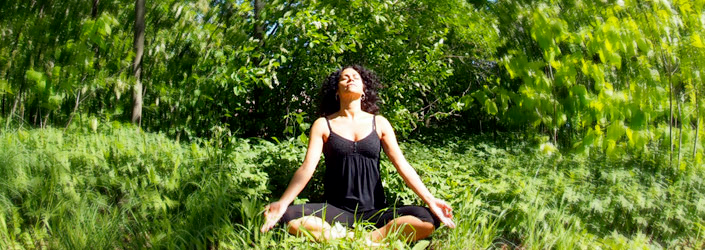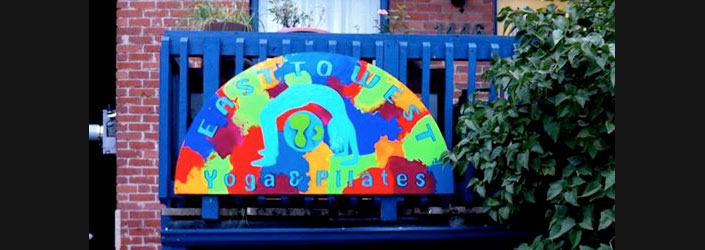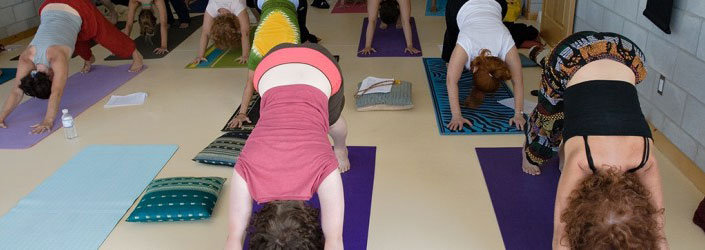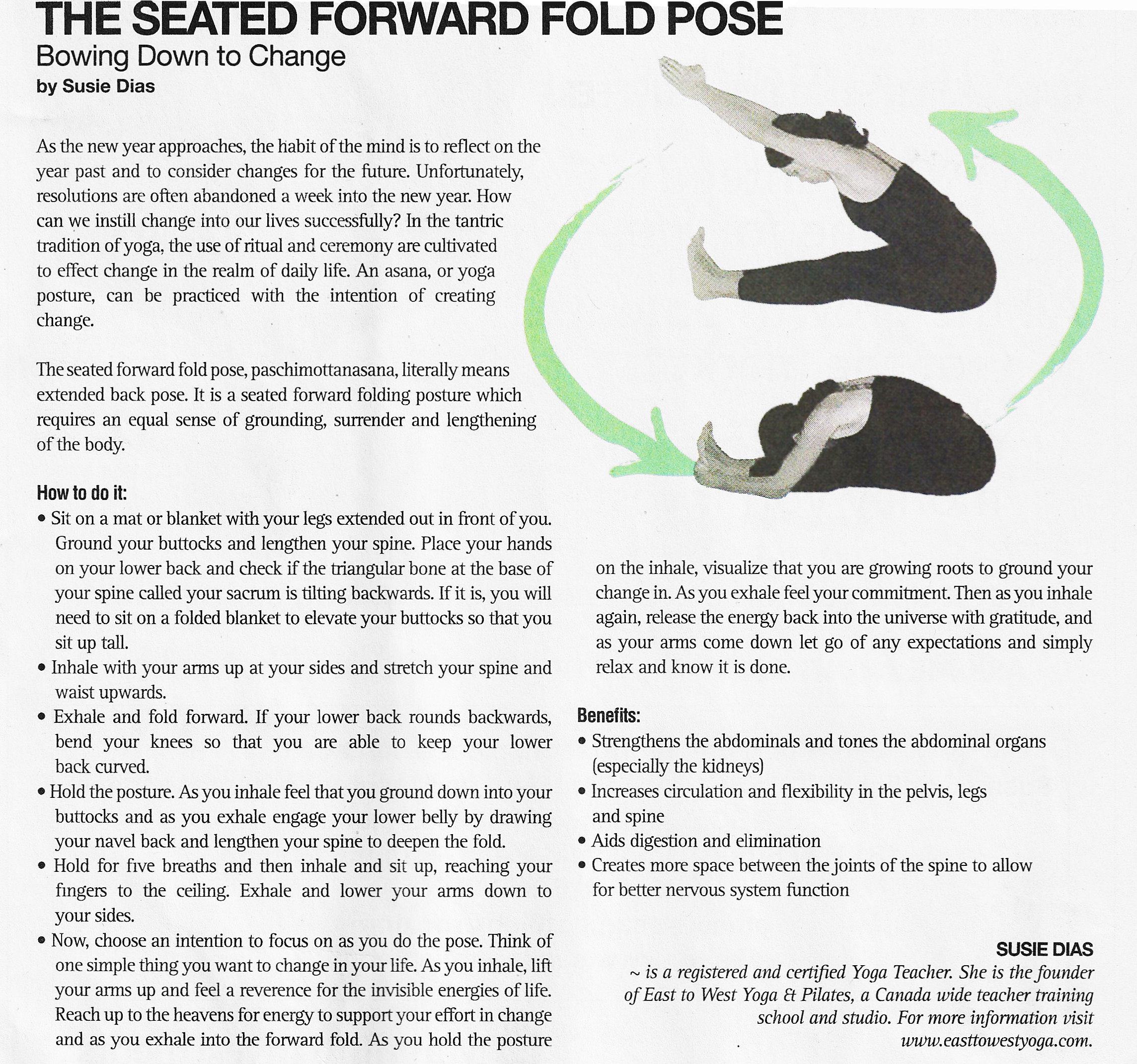Here is the class I prepared for the retreat with a theme of opening to the DIVINE FEMININE or shakti prana.
Savasana: feel the energy of the earth beneath you, relax into gravitational pull, surrender into the earth, ground down to the core of the earth and then feel her energy supporting you and energizing you.
Breath: breath into central channel of energy – sushumna nadi – feel breath moving from nostrils down to pelvic floor on inhale and up from pelvic floor using mula bandha/root lock and out through nostrils on exhale, then add belly lock/uddiyana belly, pulling navel to spine on exhale, release abdomen on inhale, feel the prana cleansing the inner channel like taking a shower, energizing and rejuvenating you, continue this deep yogic breath throughout class.
Ardha pavana muktasana/knee to Chest pose: start with bringing right knee to chest, breath up through left groin to left nasal passage opening the Ida nadi or lunar channel of energy in the body (always open Ida first, receptive, feminine energy), hold 5 breaths, repeat other side opening Pingala nadi, solar energy or masculine energy in the body, hold 5 breaths, rest in savasana after each side to feel energy flow.
Apanasana/belly breath pose: both knees to chest, exhale knees in and engage locks, inhale knees away elbows stretched still holding knees, release locks, cleansing the energy in the belly, the womb of being, repeat 5x’s, rest in savasana and feel energy flowing through belly – 2nd chakra/svadisthana – water element.
Mandalasana/circling pose: knees to chest, circle 5 times one way with breath and then 5 times the other ways, massaging the back of the second chakra – womb of being, rest in savasana, feel energy flow, then roll onto side and onto all fours.
Adho mukha virasana/downward facing hero or child’s pose with knees apart: feel breath through sushumna nadi, also you can do a shoulder stretch by rotating the triceps to the mat as you bend the elbows to place palms on upper back and hug the head with elbows, feeling the upper spine release towards the heart, relax groin and rest 5 breaths.
Ardha bhujangasana/half and full cobra: hands by armpits, squeeze shoulder blades together and elbows into side waist, lift pelvic floor or mula bandha and hold it as you inhale up into half cobra, no weight on handing, draw energy of the earth/shakti prana up the spine, lifting from mula bandha/pelvic floor, lift higher and higher, as you hold 5 breaths, strengthening upper back as well, rest in reverse savasana surrendering to earth, repeat full cobra, lift energy from mula bandha up to navel and then heart, drawing energy up sushumna nadi, hold 5 breaths, drawing energy up, keeping elbows into side body/waist, fronts of upper arm bones/humerus drawing back to open heart, rest in reverse savasana and surrender to divine mother.
Surya namaskar/sun salutation with warm up: create energy/heat/solar energy in body
Dog to plank yoga push-ups: lift from inner arches to groins dog, firm front thighs tailbone to pubic bone plank, then add modified chataranga with knees bent, elbows into side waist into cobra, lengthen front of spine, rest in child pose, repeat, then introduce option of full cataranga and go from up dog to down dog, then teach half forward fold/ardha uttanasana, lengthen front spine, then full uttanasana, bend one knee and then other lengthen inner thigh to groin, reverse swan dive to come up, do full sun salutation twice, then variation with warrior I, back leg lifts to ceiling, front leg engage hamstrings by bending knee over ankle and tucking sit bone to back knee, engage bandhas before coming and hold bandhas as you hold virabhadrasana/warrior I about 5 breaths, and keep holding bandhas as you change sides, then come up to tadasana, feel breath in sushumna nadi/central channel of energy, drawing shakti prana into body up from the mother earth/shakti divine feminine energy of embodiment
Vriksasana/tree pose: open Ida channel first by standing on left leg, then pingala by standing on right leg, as you hold pose lift pelvic floor and breath from groin to nostril drawing shakti prana through nadi, left side first, then right, hold 5 breaths each side
Trikonasana/triangle: step out to side so that right leg is forward and turned out, to cleanse ida on left with shakti prana, also focus on stretching psoas by keeping outer rotation in front leg and revolving the navel to the ceiling, also back leg feel front thigh firm and inner thigh drawing to ceiling to firm outer hip/glut med/min, repeat other side to cleanse pingala nadi by breathing from groin to nostril, hold about 5 breaths each side
Prasarita padotanasana/wide angle pose: restore energy in wide angle, bow to earth, feel you energy releasing down into mother earth, hold 5 breaths, inhale up, exhale step back to mountain at top of mat and absorb shakti prana through feet.
Surya namaskar B/sun salutation B: go slow through utkatasana/thunderbolt or chair, feel groins back, lengthen front of spine, draw upper arms by ears triceps forward, then continue using bandhas in warrior I and through push through as we practiced before, after sun saluation do standing meditation to absorb solar energy – imagine you are in a cave and the sun is shining into the cave and absorbing into your body just as mother nature absorbs the suns energy to build vitality and strength and to promote growth
Parsvakonasana/right angle pose: step out to other side, right angle the same as triangle to open nadis and stretch psoas, repeat both sides, 5 breaths each then step to top of mat
Surya namaskar A/sun saluation A to go to child pose: imagine you are in a cave an absorbing moon light, to cool and calm the body and mind Parivrrta upavista konasana/revolving seated wide angle: back leg turned out to ground sitbone, front leg turned in to release psoas at insertion, torso rotates to leg that is it bending towards to stretch psoas at origin, about 5 breaths each side
Inversion: either viparita karani/legs up the wall or sarvangasana/shoulder stand with matsyasana/fish and pavana muktasana/little boat sequence to finish asana, emphasis on feeling energy and blood flow reverses, all nadis so that the internal kundalini shakti energy can flow up to third eye for pranayam and meditation (inner limbs of practice)
Pranayama: nadi shodhana/nasal passage cleansing, Ida first, use nasagra mudra to seal right nostril, inhale left nostril like you are breathing from groin, exhale lower mudra hand, take 2 gentle breaths, repeat 5 rounds, repeat other side 5 rounds
Meditation: watch breath at nasal passages, direct focus, then switch so that the breath is watching the body and mind, so that the shakti prana or divine mother energy is healing you, absorb the prana
Savanasana: with as little movement as possible to keep to avoid disturbing the flow of prana in the body, make your way to savasana and relax, feel the energy flow and surrender to mother earth, feel her supporting you and the energy flow that you share with divine mother
(Read) How hungry the human heart is for Divine Mother, an umbilical cord that connect us to the womb of being. Feel her energy, all her to restore your sense of trust, allow yourself to feel her with your deepest instincts.
Now place your hands on your lower belly, the womb of your being, and repeat your sankalpa 3 times…feel it vibrate in your lower belly, feel yourself in the womb of the earth and that you have planted your sankalpa into the great womb to be birthed into existence. Then come back slowly at your own pace and return to seated, chant MA three times to close the class.




